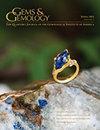高温高压合成金刚石的研究进展
IF 1.6
3区 地球科学
Q2 MINERALOGY
引用次数: 36
摘要
当然,自20世纪90年代中期以来,高温(HPHT)工艺已经商业化。本文介绍了GIA收集的数据的统计信息和独特的识别特征,主要是在纽约和卡尔斯巴德实验室收集的几千颗高温高压合成钻石。本研究包括2007年(GIA开始发布合成钻石分级报告的年份)至2016年期间提交给GIA的所有HPHT合成钻石。如此大量的HPHT合成样品尚未发表摘要。我们在这里描述了识别的诊断手段,重点是目前作为珠宝用途出售的商品。方框A详细说明了宝石学家可能使用的一些最重要的鉴定标准。在这组样本中,12%是无色到接近无色(D-J), 12%是蓝色,13%是黄色,4%是粉色到红色,54%是黄橙色到橙黄色(例如,图1)。剩下的5%显示其他颜色,包括黄绿色和棕黄色。这一组代表生长和处理过的颜色。虽然有些样品是GIA在市场上或从制造商处购买的,或由制造商借给或捐赠给我们用于研究目的,但大多数是sub-本文章由计算机程序翻译,如有差异,请以英文原文为准。
Observations on HPHT-Grown Synthetic Diamonds: A Review
sure, high-temperature (HPHT) process have been commercially available since the mid1990s. This article presents statistical information and distinctive identification features based on a review of data gathered by GIA, principally at the New York and Carlsbad laboratories, for several thousand HPHT-grown synthetic diamonds. This study includes all HPHT synthetic diamonds submitted to GIA between 2007 (the year GIA started issuing Synthetic Diamond Grading Reports) and 2016. No summary has been published on such a large number of HPHT synthetic samples. We describe here the diagnostic means of identification, with an emphasis on the goods currently being sold for jewelry use. Box A details some of the most important identification criteria that may be used by gemologists. Of this sample set, 12% were colorless to nearcolorless (D–J), 12% blue, 13% yellow, 4% pink to red, and 54% yellowish orange to orangy yellow (e.g., figure 1). The remaining 5% showed other colors, including green-yellow and brown-orange. This set represents both as-grown and treated colors. While some samples were purchased by GIA on the market or from manufacturers, or were loaned or donated to us by manufacturers for study purposes, most were sub-
求助全文
通过发布文献求助,成功后即可免费获取论文全文。
去求助
来源期刊

Gems & Gemology
地学-矿物学
CiteScore
2.90
自引率
19.20%
发文量
10
期刊介绍:
G&G publishes original articles on gem materials and research in gemology and related fields. Manuscript topics include, but are not limited to:
Laboratory or field research;
Comprehensive reviews of important topics in the field;
Synthetics, imitations, and treatments;
Trade issues;
Recent discoveries or developments in gemology and related fields (e.g., new instruments or identification techniques, gem minerals for the collector, and lapidary techniques);
Descriptions of notable gem materials and localities;
Jewelry manufacturing arts, historical jewelry, and museum exhibits.
 求助内容:
求助内容: 应助结果提醒方式:
应助结果提醒方式:


